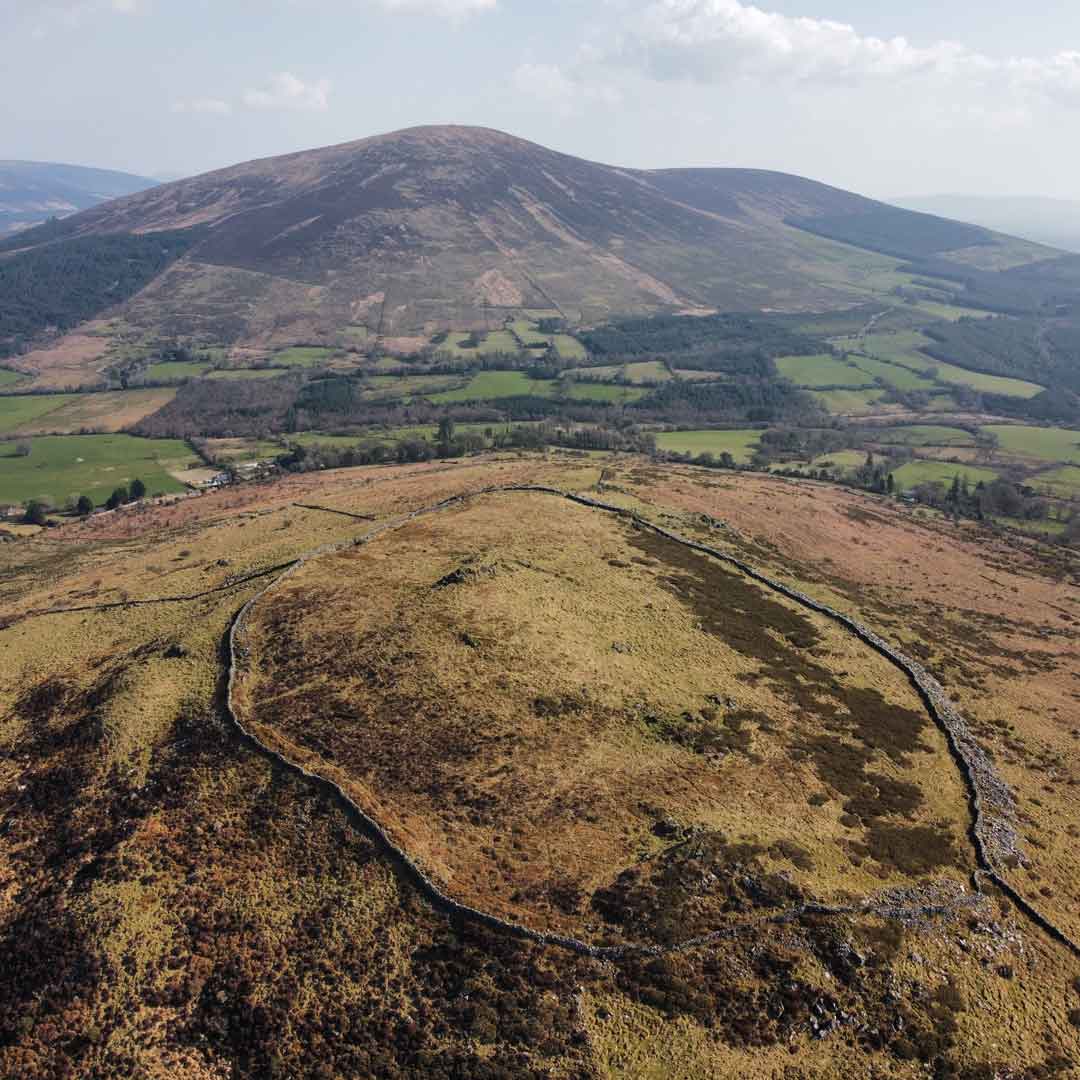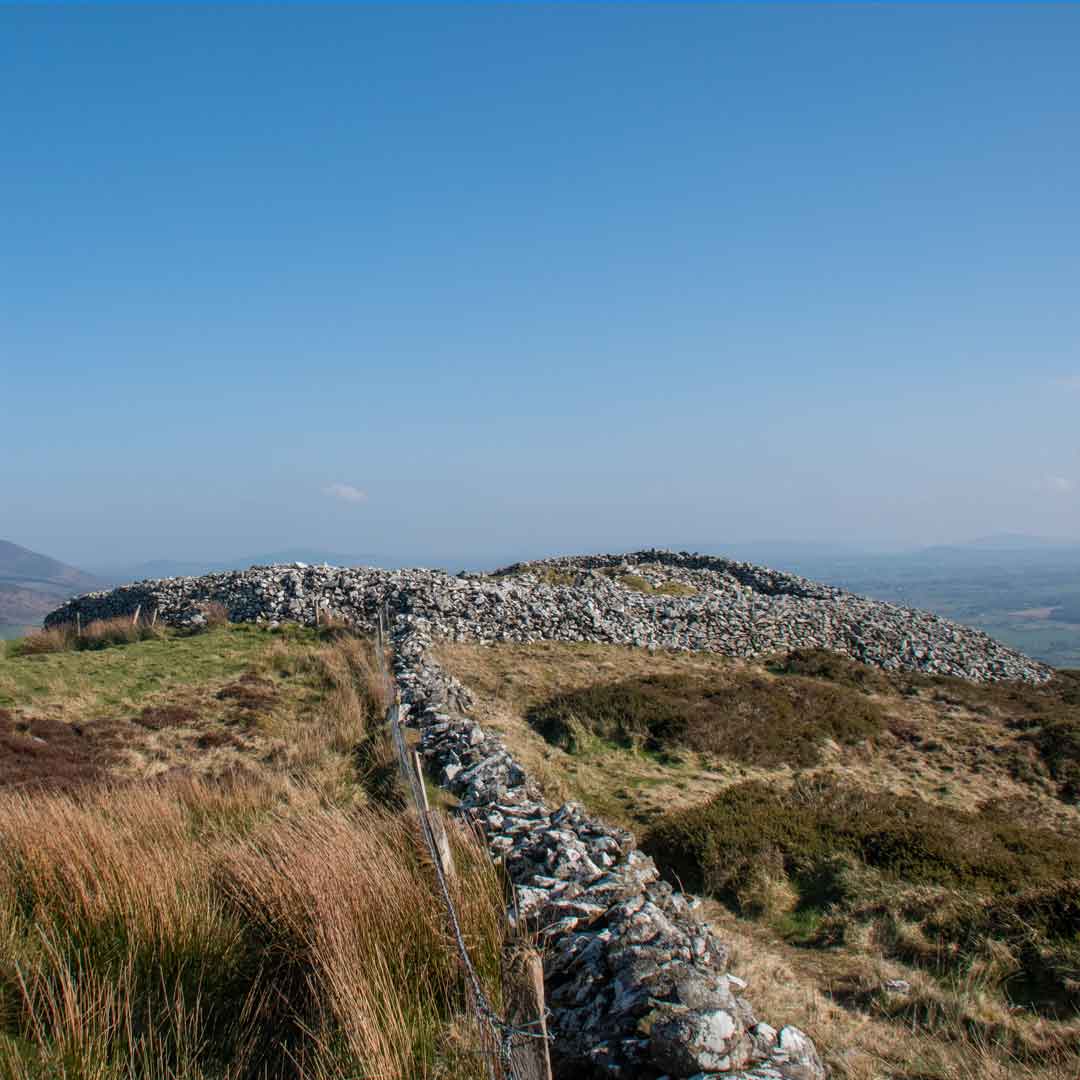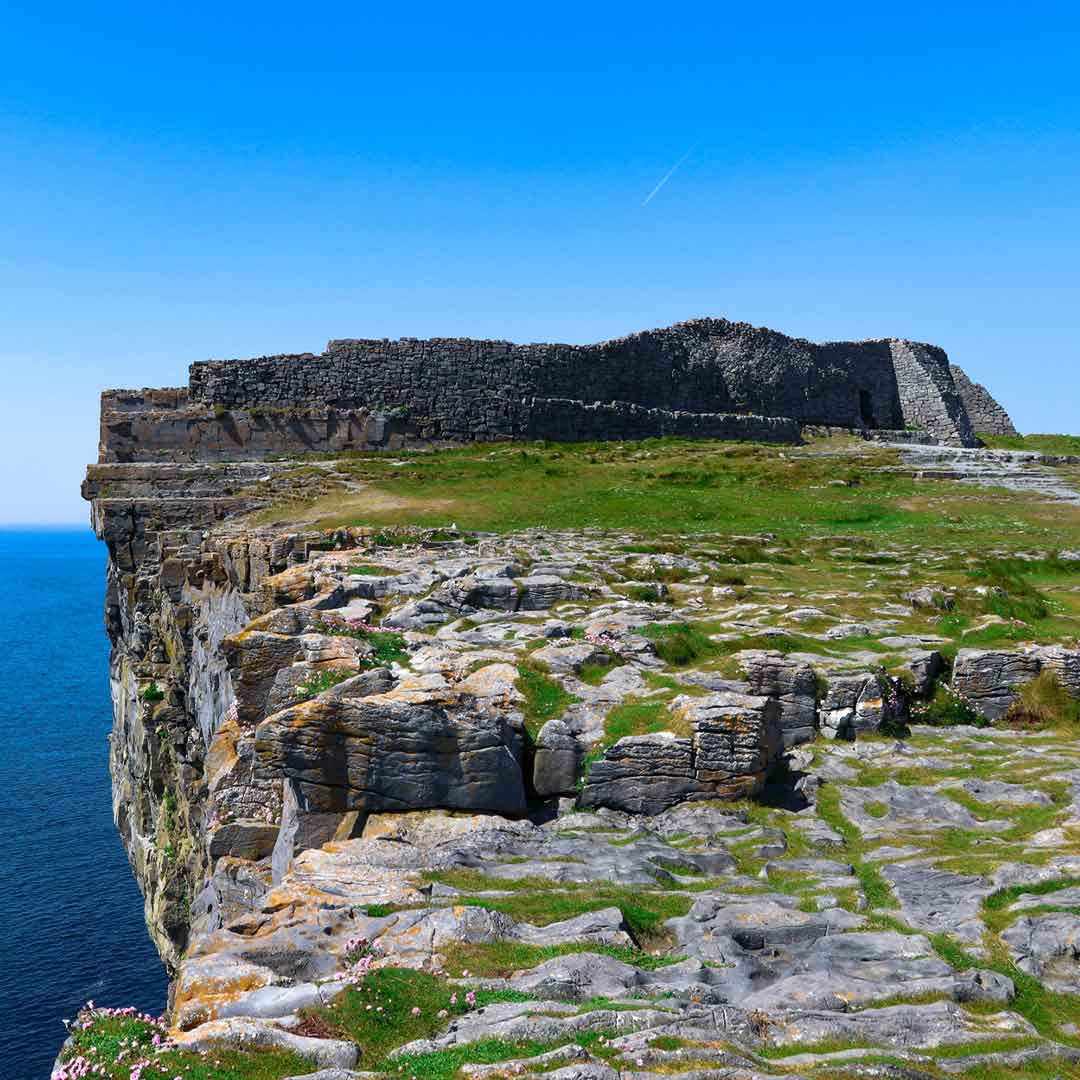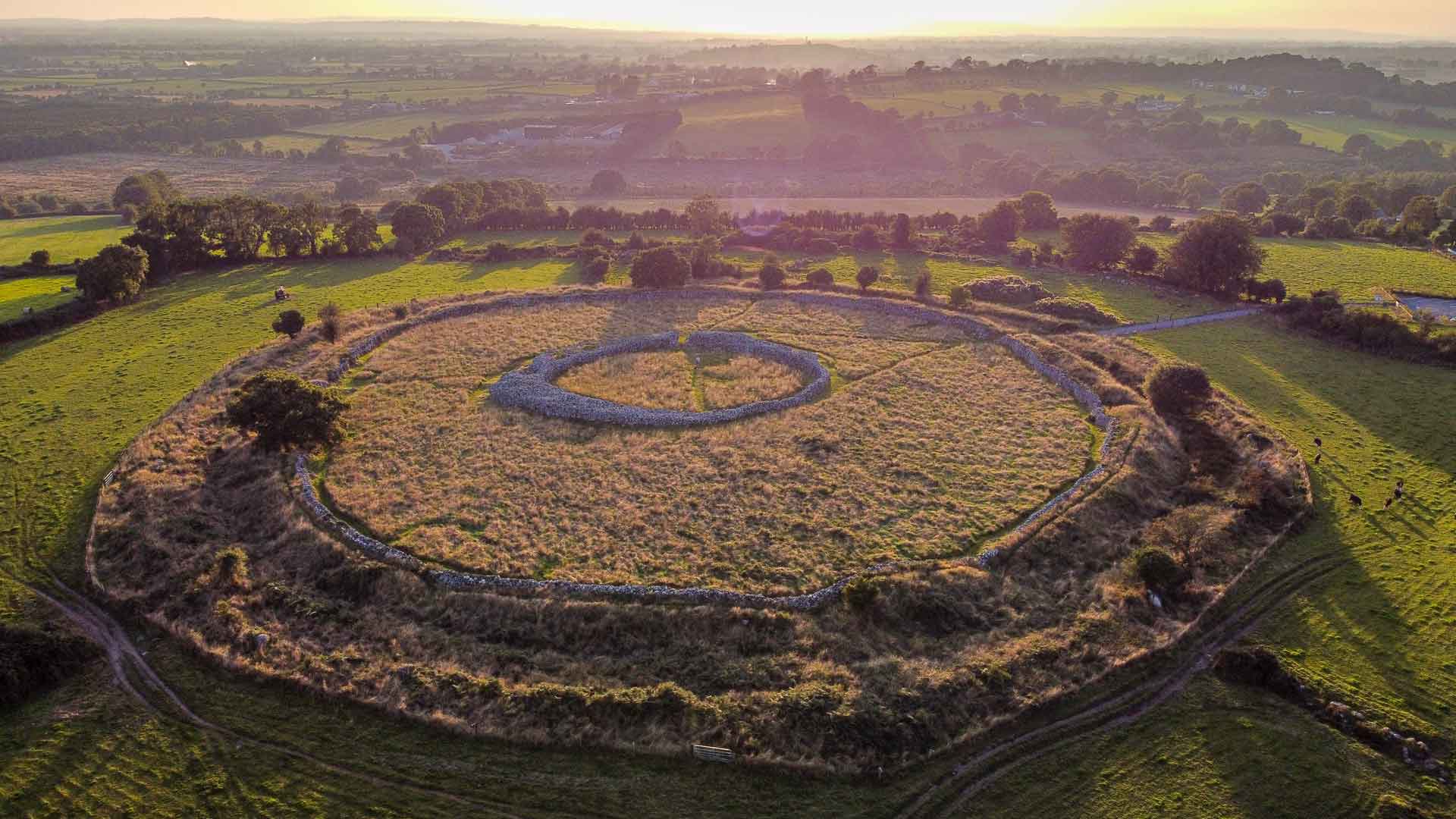
Hillforts
Hillforts are some of the best known and certainly the largest monuments of the later prehistoric period in Ireland. They were centres of ceremony and assembly, a visual expression of power in the landscape. Their immense size testifies to the significance these central places held in economic, political and idealogical terms for societies of the later Bronze Age.
Hillforts are usually located at the summit or ridge of a hill or hills which, if not high, are visually prominent. They are defined by large earthen banks or stone walls, with an external fosse/ditch. They are usually circular or oval in shape, although many follow the contours of the hill they are located on. Similar forts, usually made of stone, are located on cliff-edges and promontories in both coastal areas and inland.
Although a few examples date from the Early Neolithic (c. 3800-3600 BC), most Hillforts were constructed during the Middle to Late Bronze Age (c. 1400-500 BC) with examples of reoccupation & reconstruction in the later Iron Age and Early Medieval periods (c. 100-800 AD).
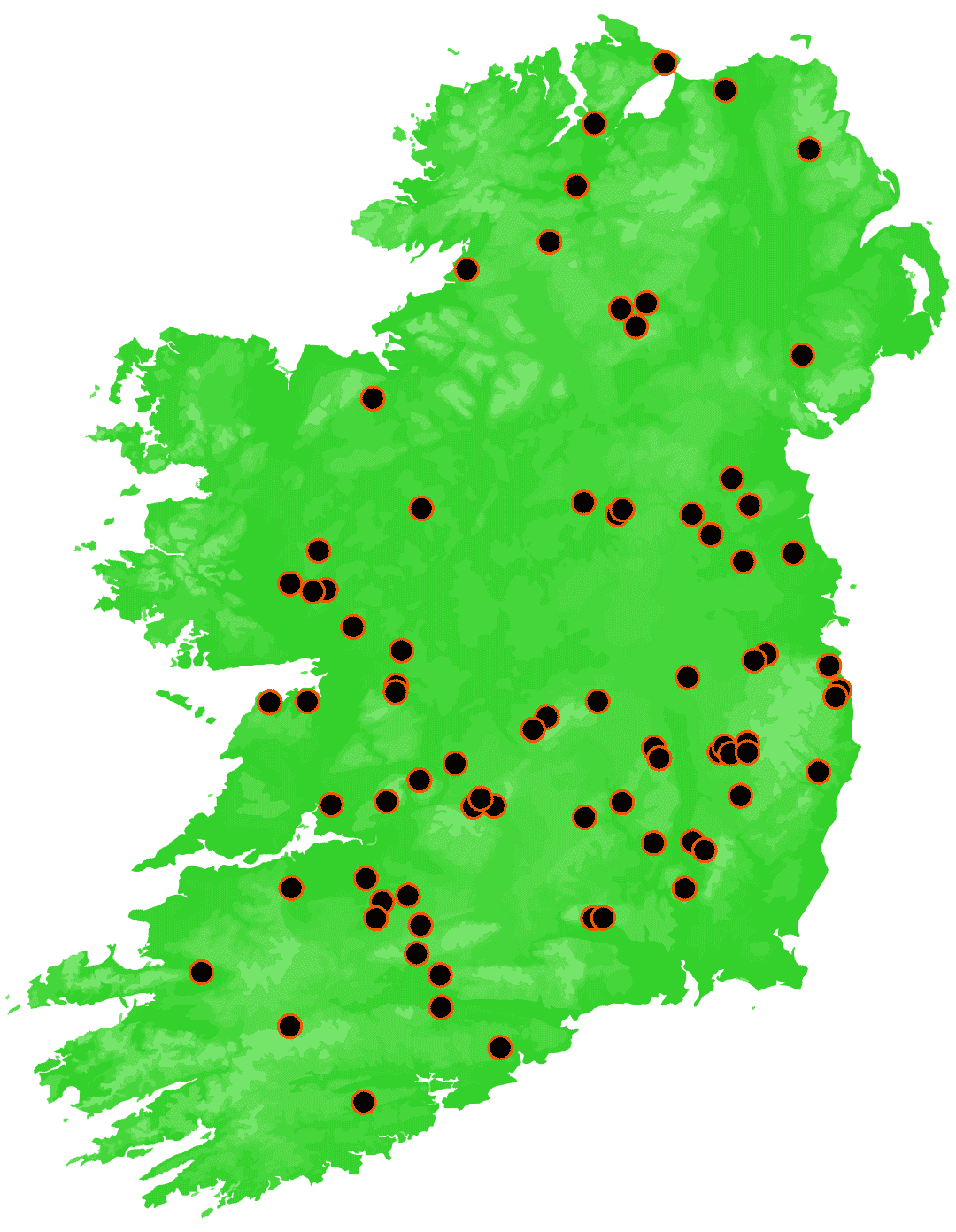
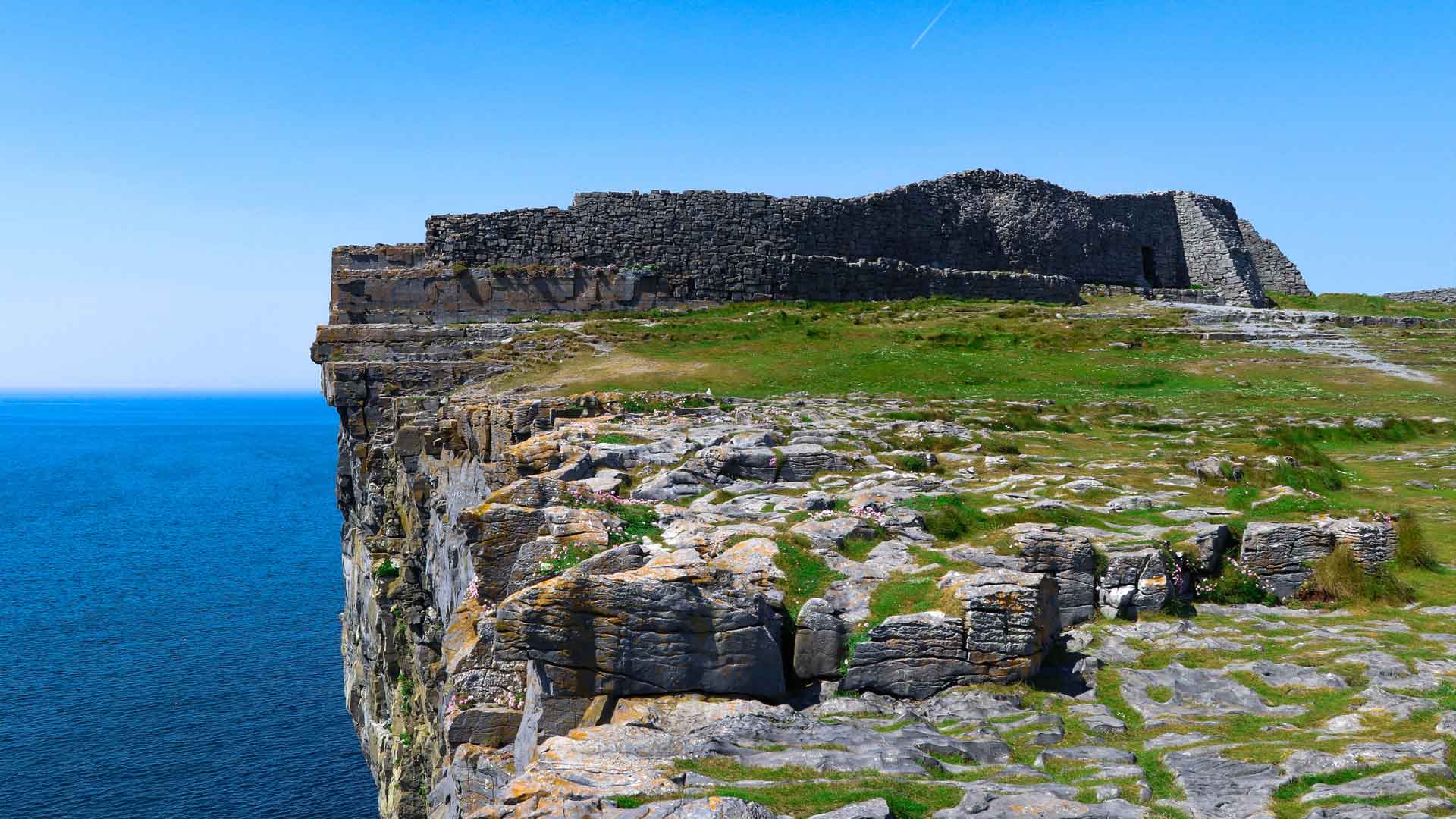
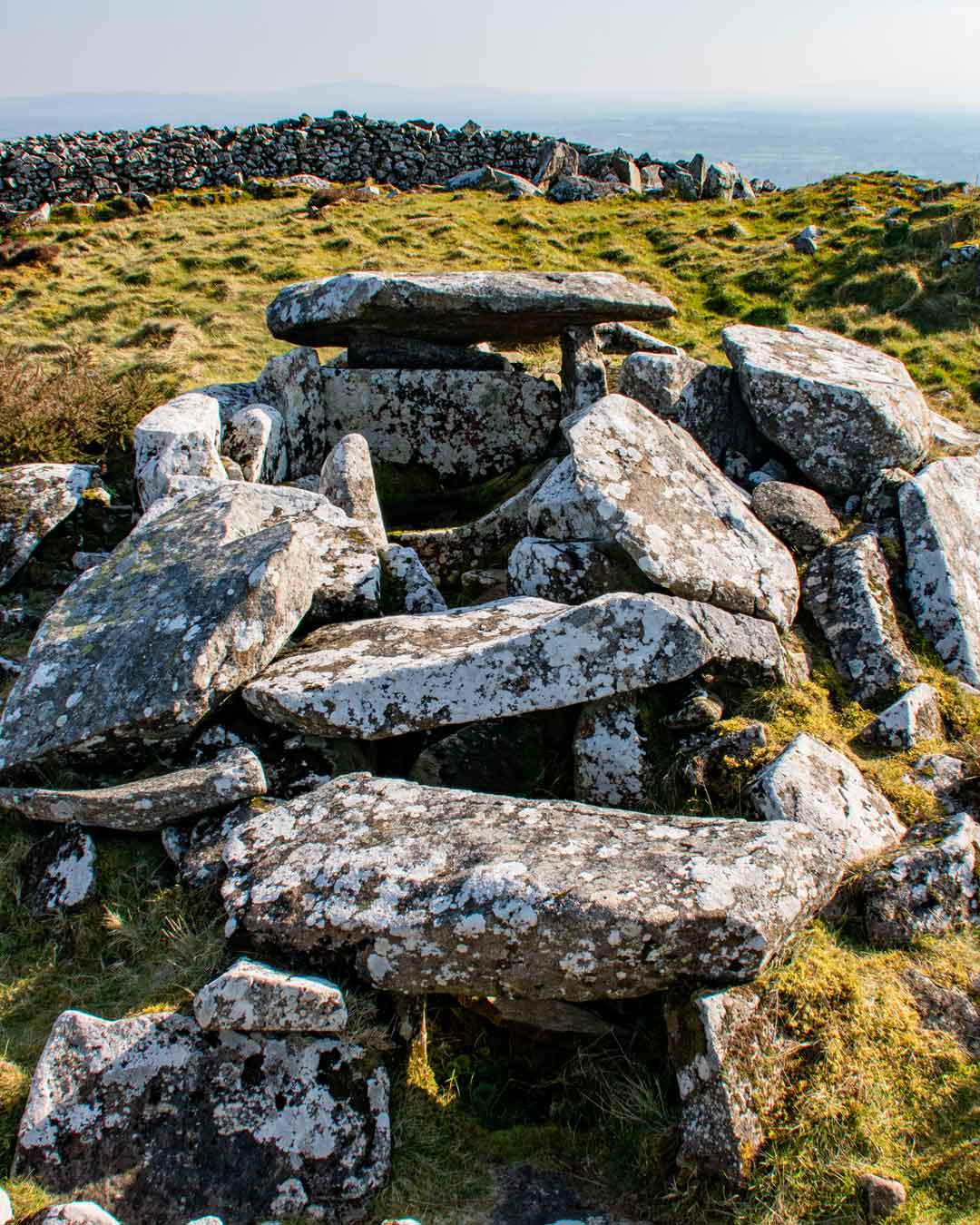
The first ‘hill forts’ may have been the large hilltop enclosures built by the farming communities of the Early-Neolithic c.3700-3500BCE, when a warmer climate in Ireland allowed for growing crops in upland areas. These sites were part of the wider phenomenon of settlement, land enclosure and monumental construction during this period.
However, as with the later Bronze-Age Hillforts, the construction/siting of ritual monuments within these hilltop enclosures does not rule out a defensive purpose for the enclosures themselves. Unlike Neolithic Henge monuments or later Ceremonial Enclosures that have the fosse/ditch on the inside of the bank - Hillforts, with their external fosses/ditches, were designed for defence.
While the Neolithic is often presented as some kind peaceful utopia, there is much evidence of conflict among early farming populations. Although these Neolithic Hill forts/settlements were not yet the visual displays of power that characterise the later Bronze Age Hillforts; part of their function would have been the protection of human life and property.
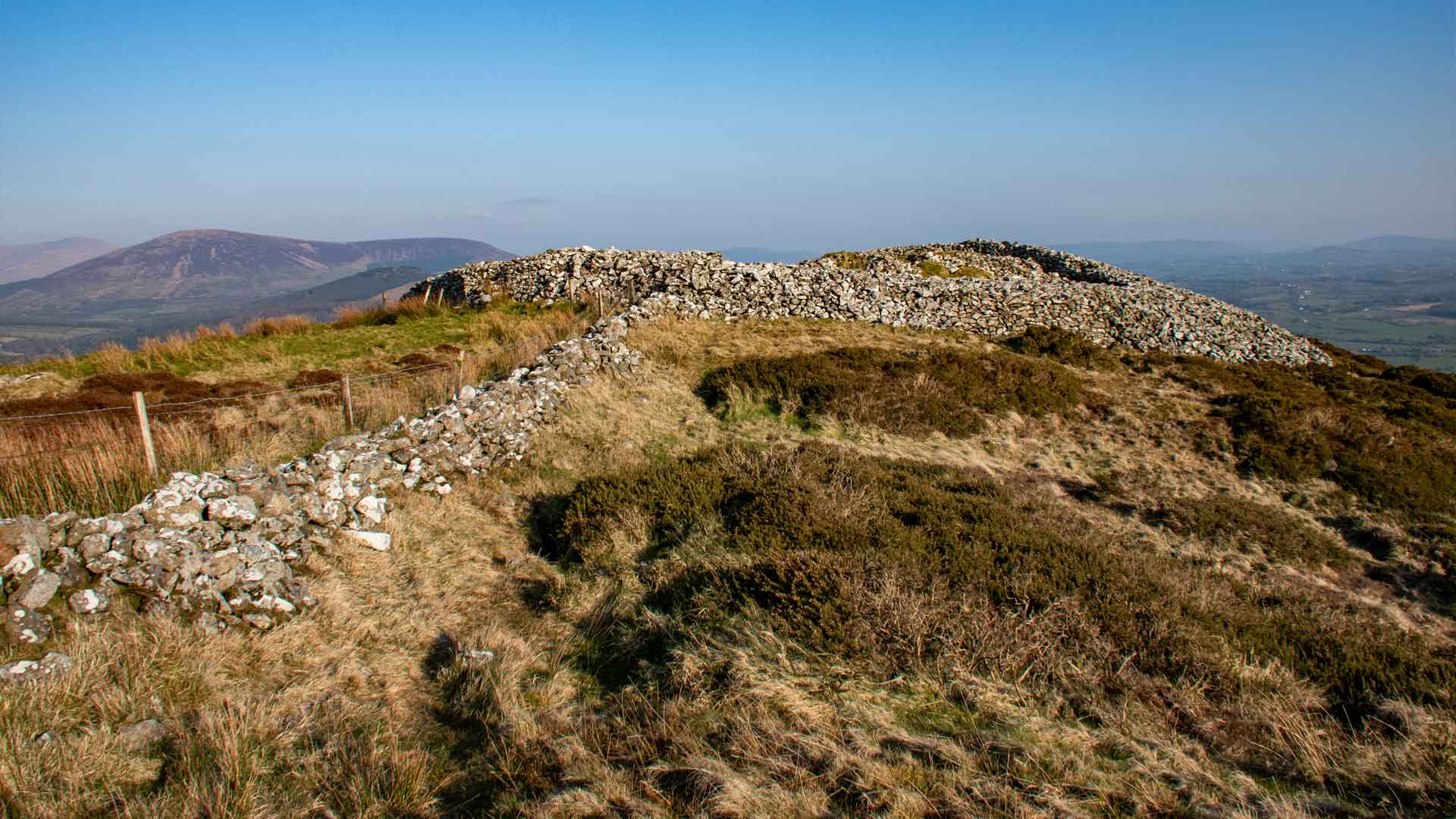
Although hilltop locations have been in use as fortified settlement sites since the early Neolithic, the construction of the huge, ramparted Hillforts, we still see on the landscape, doesn’t begin until the mid-late Bronze Age, over 2000 years later. However by this time the function of hill forts has had to adapt in response to changing political, socio-economic & environmental circumstances.
Toward the end of the Neolithic (3500BCE) as the climate in Ireland became wetter and colder, upland areas that could no longer support arable farming became summer pastures for livestock. This was part of a wider change to a new type of pastoral farming known as ‘transhumance’: The seasonal movement of livestock between fixed summer and winter pastures.
By the time the classic Hillforts were being constructed in the Mid to Late Bronze-Age (c.1200BCE), the Neolithic population of Ireland had been almost completely replaced by Indo-European speaking peoples with their origins in the Pontic Steppe. This was a period of great change in Ireland, with population growth and settlement expansion all across the island.
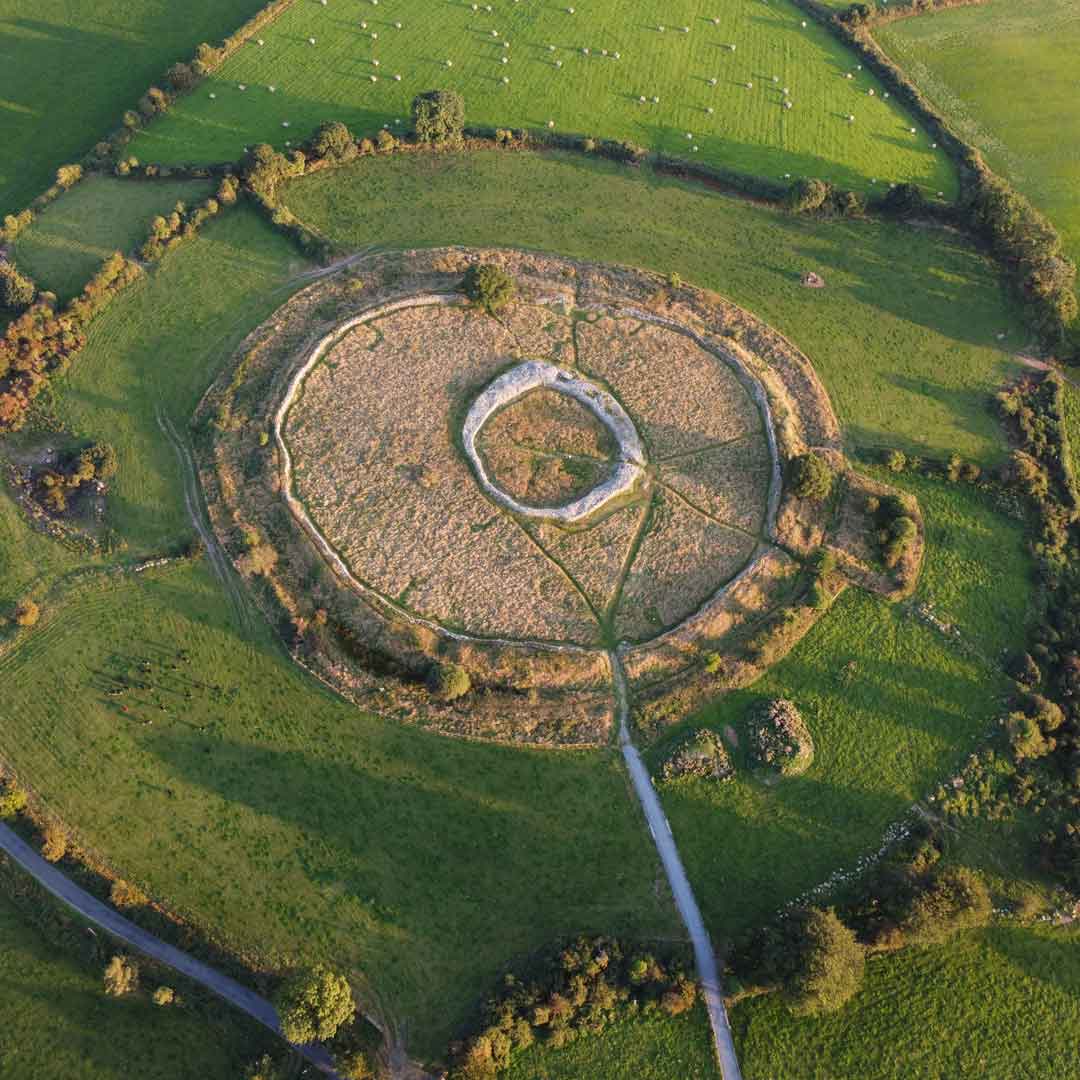

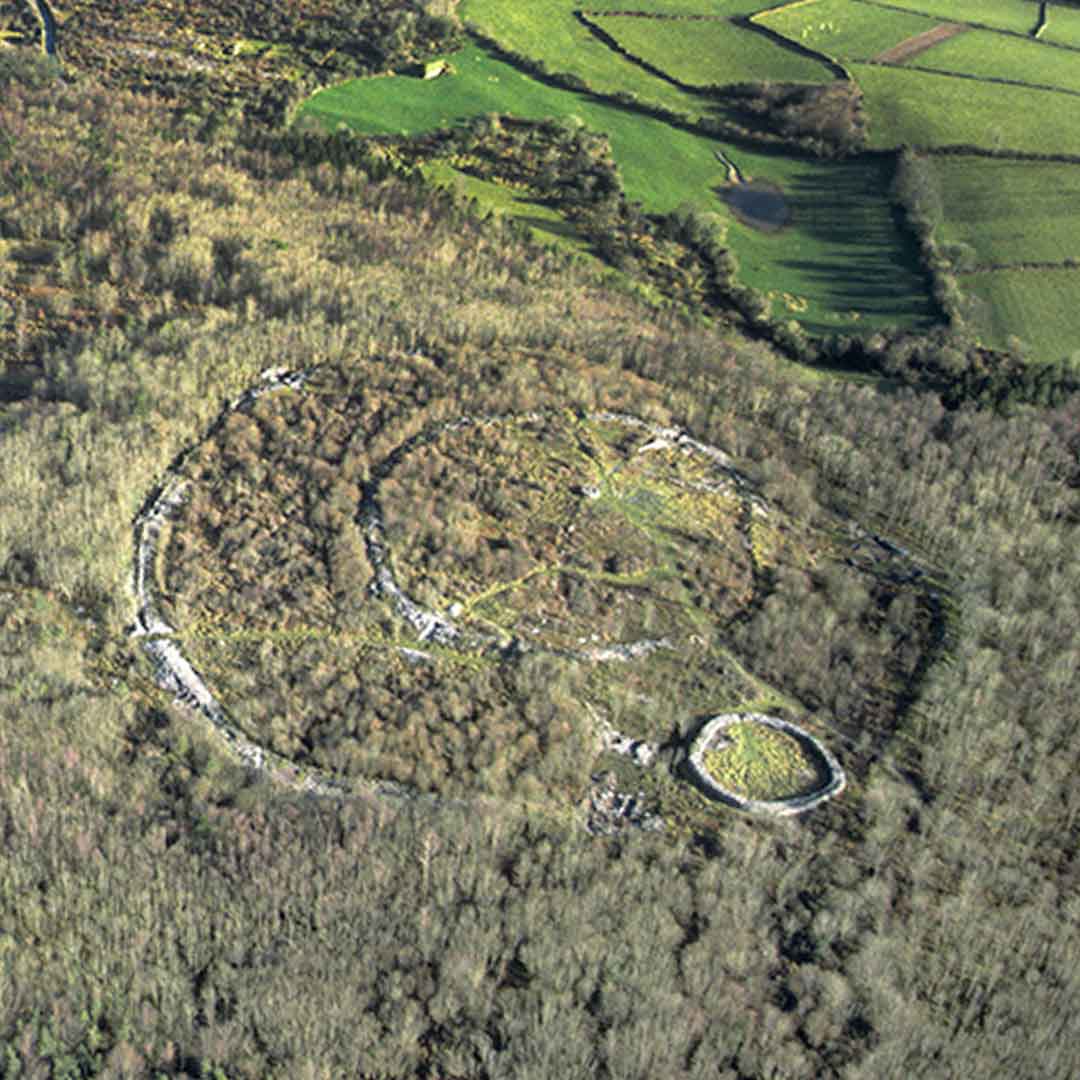
Hillforts are often associated with the emergence of a new type of political structure in Ireland; centralised leadership in social formations, known as ‘chiefdoms’. The imposing size of these great enclosures and their prominent settings, were a display of a chiefdoms (and its chief’s) power in the landscape.
These hilltop sites would have been the prime locations for people to come together as a community, both in their construction and subsequent usage, providing a very visual statement of belonging to those within the community and perhaps a statement of control/power to those outside.
It is no wonder then, that the construction of Hillforts during this period has been linked with the development of the Irish language and they are perhaps the first monumental signs of an Irish/Gaelic identity.
Check out the examples of Hillforts below or click here to view all fortifications.
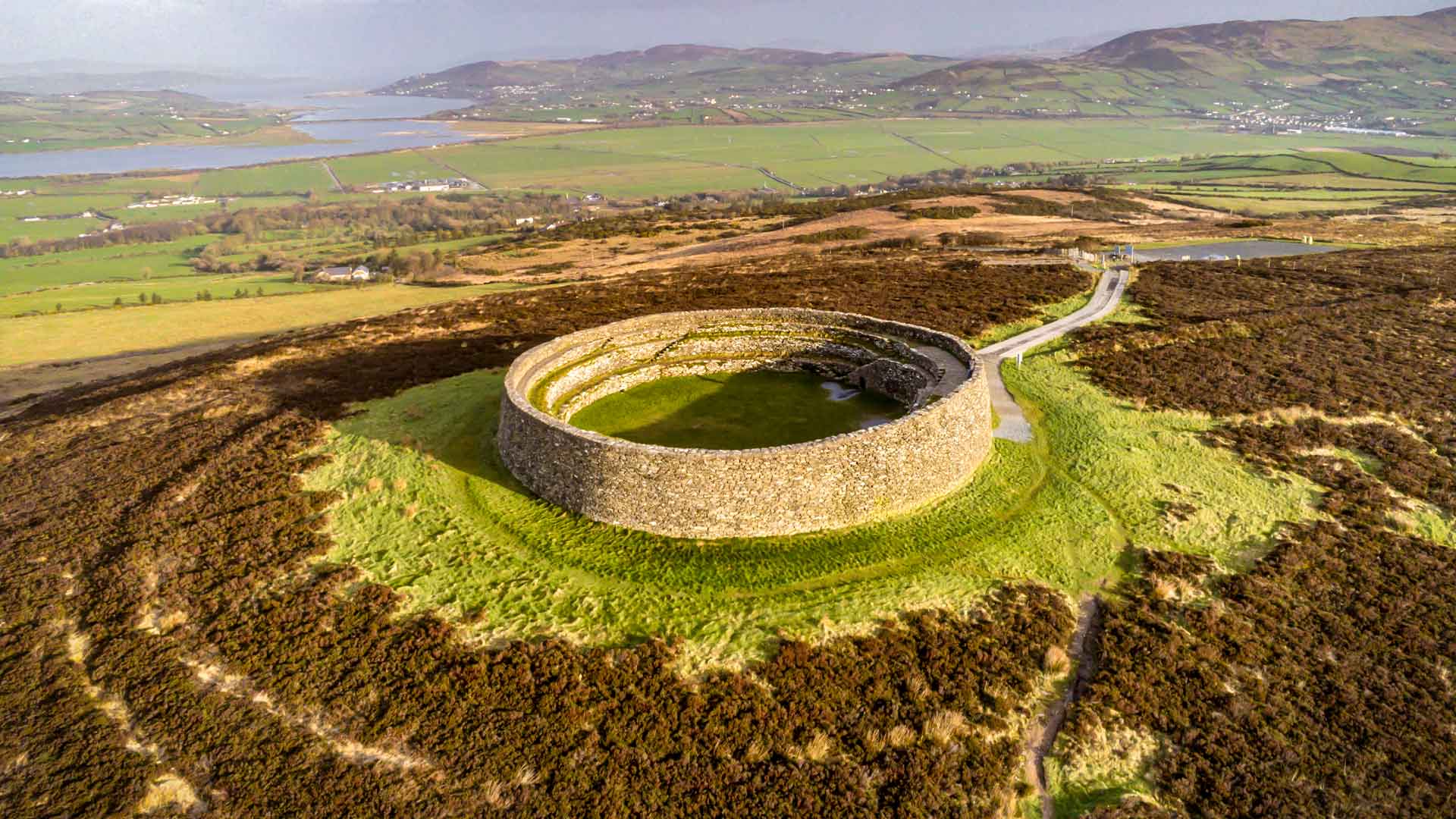
Examples of Hillforts

Hillforts
Hillforts are some of the best known and certainly the largest monuments of the later prehistoric period in Ireland. They were centres of ceremony and assembly, a visual expression of power in the landscape. Their immense size testifies to the significance these central places held in economic, political and idealogical terms for societies of the later Bronze Age.
Hillforts are usually located at the summit or ridge of a hill or hills which, if not high, are visually prominent. They are defined by large earthen banks or stone walls, with an external fosse/ditch. They are usually circular or oval in shape, although many follow the contours of the hill they are located on. Similar forts, usually made of stone, are located on cliff-edges and promontories in both coastal areas and inland.
Although a few examples date from the Early Neolithic (c. 3800-3600 BC), most Hillforts were constructed during the Middle to Late Bronze Age (c. 1400-500 BC) with examples of reoccupation & reconstruction in the later Iron Age and Early Medieval periods (c. 100-800 AD).



The first ‘hill forts’ may have been the large hilltop enclosures built by the farming communities of the Early-Neolithic c.3700-3500BCE, when a warmer climate in Ireland allowed for growing crops in upland areas. These sites were part of the wider phenomenon of settlement, land enclosure and monumental construction during this period.
However, as with the later Bronze-Age Hillforts, the construction/siting of ritual monuments within these hilltop enclosures does not rule out a defensive purpose for the enclosures themselves. Unlike Neolithic Henge monuments or later Ceremonial Enclosures that have the fosse/ditch on the inside of the bank - Hillforts, with their external fosses/ditches, were designed for defence.
While the Neolithic is often presented as some kind peaceful utopia, there is much evidence of conflict among early farming populations. Although these Neolithic Hill forts/settlements were not yet the visual displays of power that characterise the later Bronze Age Hillforts; part of their function would have been the protection of human life and property.

Although hilltop locations have been in use as fortified settlement sites since the early Neolithic, the construction of the huge, ramparted Hillforts, we still see on the landscape, doesn’t begin until the mid-late Bronze Age, over 2000 years later. However by this time the function of hill forts has had to adapt in response to changing political, socio-economic & environmental circumstances.
Toward the end of the Neolithic (3500BCE) as the climate in Ireland became wetter and colder, upland areas that could no longer support arable farming became summer pastures for livestock. This was part of a wider change to a new type of pastoral farming known as ‘transhumance’: The seasonal movement of livestock between fixed summer and winter pastures.
By the time the classic Hillforts were being constructed in the Mid to Late Bronze-Age (c.1200BCE), the Neolithic population of Ireland had been almost completely replaced by Indo-European speaking peoples with their origins in the Pontic Steppe. This was a period of great change in Ireland, with population growth and settlement expansion all across the island.



Although hilltop locations have been in use as fortified settlement sites since the early Neolithic, the construction of the huge, ramparted Hillforts, we still see on the landscape, doesn’t begin until the mid-late Bronze Age, over 2000 years later. However by this time the function of hill forts has had to adapt in response to changing political, socio-economic & environmental circumstances.
Toward the end of the Neolithic (3500BCE) as the climate in Ireland became wetter and colder, upland areas that could no longer support arable farming became summer pastures for livestock. This was part of a wider change to a new type of pastoral farming known as ‘transhumance’: The seasonal movement of livestock between fixed summer and winter pastures.
By the time the classic Hillforts were being constructed in the Mid to Late Bronze-Age (c.1200BCE), the Neolithic population of Ireland had been almost completely replaced by Indo-European speaking peoples with their origins in the Pontic Steppe. This was a period of great change in Ireland, with population growth and settlement expansion all across the island.

Examples of Hillforts

Hillforts
Hillforts are some of the best known and certainly the largest monuments of the later prehistoric period in Ireland. They were centres of ceremony and assembly, a visual expression of power in the landscape. Their immense size testifies to the significance these central places held in economic, political and idealogical terms for societies of the later Bronze Age.
Hillforts are usually located at the summit or ridge of a hill or hills which, if not high, are visually prominent. They are defined by large earthen banks or stone walls, with an external fosse/ditch. They are usually circular or oval in shape, although many follow the contours of the hill they are located on. Similar forts, usually made of stone, are located on cliff-edges and promontories in both coastal areas and inland.
Although a few examples date from the Early Neolithic (c. 3800-3600 BC), most Hillforts were constructed during the Middle to Late Bronze Age (c. 1400-500 BC) with examples of reoccupation & reconstruction in the later Iron Age and Early Medieval periods (c. 100-800 AD).


The first ‘hill forts’ may have been the large hilltop enclosures built by the farming communities of the Early-Neolithic c.3700-3500BCE, when a warmer climate in Ireland allowed for growing crops in upland areas. These sites were part of the wider phenomenon of settlement, land enclosure and monumental construction during this period.
However, as with the later Bronze-Age Hillforts, the construction/siting of ritual monuments within these hilltop enclosures does not rule out a defensive purpose for the enclosures themselves. Unlike Neolithic Henge monuments or later Ceremonial Enclosures that have the fosse/ditch on the inside of the bank - Hillforts, with their external fosses/ditches, were designed for defence.
While the Neolithic is often presented as some kind peaceful utopia, there is much evidence of conflict among early farming populations. Although these Neolithic Hill forts/settlements were not yet the visual displays of power that characterise the later Bronze Age Hillforts; part of their function would have been the protection of human life and property.


Although hilltop locations have been in use as fortified settlement sites since the early Neolithic, the construction of the huge, ramparted Hillforts, we still see on the landscape, doesn’t begin until the mid-late Bronze Age, over 2000 years later. However by this time the function of hill forts has had to adapt in response to changing political, socio-economic & environmental circumstances.
Toward the end of the Neolithic (3500BCE) as the climate in Ireland became wetter and colder, upland areas that could no longer support arable farming became summer pastures for livestock. This was part of a wider change to a new type of pastoral farming known as ‘transhumance’: The seasonal movement of livestock between fixed summer and winter pastures.
By the time the classic Hillforts were being constructed in the Mid to Late Bronze-Age (c.1200BCE), the Neolithic population of Ireland had been almost completely replaced by Indo-European speaking peoples with their origins in the Pontic Steppe. This was a period of great change in Ireland, with population growth and settlement expansion all across the island.


Hillforts are often associated with the emergence of a new type of political structure in Ireland; centralised leadership in social formations, known as ‘chiefdoms’. The imposing size of these great enclosures and their prominent settings, were a display of a chiefdoms (and its chief’s) power in the landscape.
These hilltop sites would have been the prime locations for people to come together as a community, both in their construction and subsequent usage, providing a very visual statement of belonging to those within the community and perhaps a statement of control/power to those outside.
It is no wonder then, that the construction of Hillforts during this period has been linked with the development of the Irish language and they are perhaps the first monumental signs of an Irish/Gaelic identity.
Check out the examples of Hillforts below or click here to view all fortifications.



